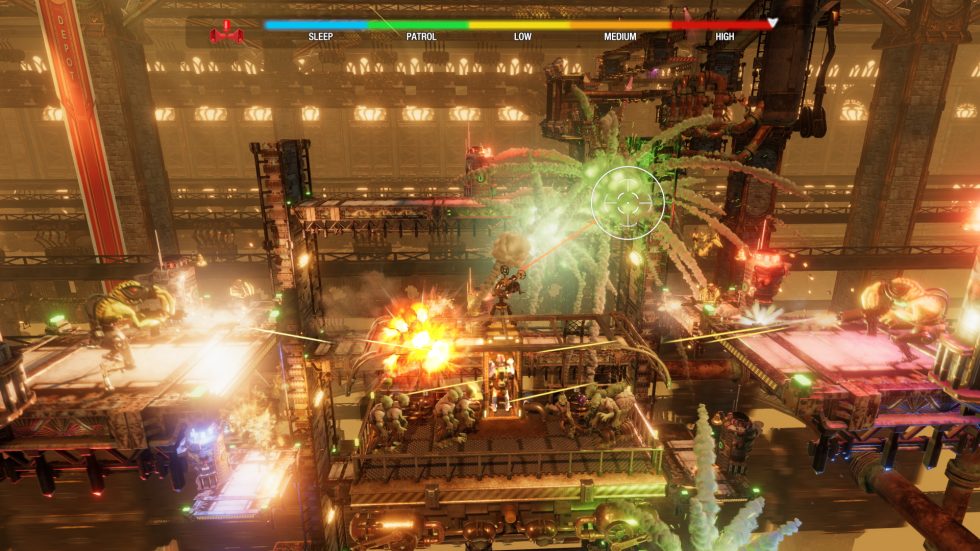SANTA MONICA, Calif.—Video game fans of a certain age may remember when pre-rendered sprites dominated every platform in the mid-90s. In the decades since, some of those games (like Donkey Kong Country) have turned out far more timeless-looking than others (like Clayfighter 63 1/3).
1997's Oddworld: Abe's Odyssee has arguably aged the best out of all of its peers, with its incredible animations and balanced full-scene lighting, but that's the silver lining for a series that has otherwise remained pretty dormant (assuming you ignore the series' uneven attempts to go fully polygonal). I for one remember wondering if an Oddworld game might ever look and feel as exciting on a modern-day platform—not just in remake form (a la Oddworld: New & Tasty) but in having its gameplay and engine supercharged.
And that's why I'm writing about Oddworld Soulstorm, the series' first new 2D entry since 1998's Exoddus.
There's no guarantee that the final game, slated for a "2020" launch, will turn out all that remarkable. But after attending the world-premiere gameplay session at a pre-E3 showcase, I came away impressed and optimistic. The game's original 2D mechanics have returned, only revamped with a Pikmin-like follower system, a new crafting interface, explosive weaponry, and impressively destructible environments.
The pied Mudokon piper
As Abe sneaks, so do the other Mudokons. An emphasis on specific material qualities means that Abe's use of fiery weaponry has a real impact on everything in sight. This dramatic shot of an oncoming train actually resembles the real-time gameplay I saw. And if you're not careful about how you lead your fellow Mudokons through this sequence, said train will turn them into a glorious pile of gibs. Peep through a pair of binoculars to plot out a sneaking strategy, if you're not interested in all of that violence. (There are apparent rewards for choosing stealthier paths.) That is a lot of Mudokon allies. I wonder if the game will truly scale to current-gen CPUs, in terms of animating them all simultaneously.
You may have already seen the content that I sampled, as Oddworld's developers snuck a few gameplay moments into an early May teaser trailer. The level in question revolves around familiar Oddworld 2D-gaming elements: run through an NPC-filled industrial landscape while saving allies, employing stealth, dealing with guards, and figuring out door-switching puzzles.
The first eye-catching difference in this game is a shift to a 2.5-dimensional perspective, which Soulstorm creative director/writer/chief designer Lorne Lanning called "2.9-D." In some moments, this simply attaches a cinematic perspective to a straight-ahead path, but in others, it affords an impressive look at later-level challenges in the background.
The level in question was described as something "halfway through the game," but on its face, the challenge seemed more like something out of an early tutorial. As Abe, your goal is to free your fellow Mudokons from their lives of servitude, so you must sneak into their workplace, "sing" them away from their job posts, and guide them to a portal at the level's end. (You use an in-game menu to order those followers to "stay," "follow," or "mimic" as needed.)
Along the way, Abe needs to pick through trash cans and lockers to snag crucial supplies, which he then uses to craft a variety of weapons and items. We didn't see many crafting possibilities that catered to quieter or more stealth-like progression; most of what Lanning put into our inventories (via a cheat code, thanks dude) was either concussive projectiles, explosive bombs, or Molotov cocktails. On the quieter side, these were countered by some noise-making distraction items and some bouncy, "put guards to sleep" rubber-band balls, at least.
The fireworks really started going off when we learned that we could equip our followers—a legion of roughly two dozen Mudokons by the level's end—with any of these items. In one auto-scrolling sequence, where I had to pilot a moving platform through a gauntlet of turrets while aiming my own gun like a laser-gun scope around the screen, my allies used their equipped items to fight back and keep Abe safe. It wasn't clear whether the helpers could be so aggressive in other parts of the game.
Sure, Abe can stealth… but why?

Performance?
In a brief chat with Ars, Soulstorm Executive Producer Bennie Terry III revealed that the game (and its explosions and alpha effects) has been scaled with current-gen console performance in minRead More – Source
[contf] [contfnew] 
Ars Technica
[contfnewc] [contfnewc]







